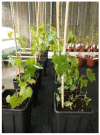Elimination of Eight Viruses and Two Viroids from Preclonal Candidates of Six Grapevine Varieties (Vitis vinifera L.) through In Vivo Thermotherapy and In Vitro Meristem Tip Micrografting
- PMID: 35448791
- PMCID: PMC9029751
- DOI: 10.3390/plants11081064
Elimination of Eight Viruses and Two Viroids from Preclonal Candidates of Six Grapevine Varieties (Vitis vinifera L.) through In Vivo Thermotherapy and In Vitro Meristem Tip Micrografting
Abstract
Viruses and virus-like organisms are a major problem in viticulture worldwide. They cannot be controlled by standard plant protection measures, and once infected, plants remain infected throughout their life; therefore, the propagation of healthy vegetative material is crucial. In vivo thermotherapy at 36-38 °C for at least six weeks, followed by meristem tip micrografting (0.1-0.2 mm) onto in vitro-growing seedling rootstocks of Vialla (Vitis labrusca × Vitis riparia), was successfully used to eliminate eight viruses (grapevine rupestris stem pitting-associated virus (GRSPaV), grapevine Pinot gris virus (GPGV), grapevine fanleaf virus (GFLV), grapevine leafroll-associated virus 3 (GLRaV-3), grapevine fleck virus (GFkV), grapevine rupestris vein feathering virus (GRVFV), grapevine Syrah virus-1 (GSyV-1), and raspberry bushy dwarf virus (RBDV)), as well as two viroids (hop stunt viroid (HSVd) and grapevine yellow speckle viroid 1 (GYSVd-1)) from preclonal candidates of six grapevine varieties (Vitis vinifera L.). A half-strength MS medium including vitamins supplemented with 30 g/L of sucrose and solidified with 8 g/L of agar, without plant growth regulators, was used for the growth and root development of micrografts and the subsequently micropropagated plants; no callus formation, hyperhydricity, or necrosis of shoot tips was observed. Although the overall regeneration was low (higher in white than in red varieties), a 100% elimination was achieved for all eight viruses, whereas the elimination level for viroids was lower, reaching only 39.2% of HSVd-free and 42.6% GYSVd-1-free vines. To the best of our knowledge, this is the first report of GPGV, GRVFV, GSyV-1, HSVd, and GYSVd-1 elimination through combining in vivo thermotherapy and in vitro meristem tip micrografting, and the first report of RBDV elimination from grapevines. The virus-free vines were successfully acclimatized in rockwool plugs and then transferred to soil.
Keywords: Vitis vinifera L.; grapevine viruses and viroids; micrografting; thermotherapy.
Conflict of interest statement
The authors declare no conflict of interest.
Figures






References
-
- Andret-Link P., Laporte C., Valat L., Ritzenthaler C., Demangeat G., Vigne E., Laval V., Pfeiffer P., Stussi-Garaud C., Fuchs M. Grapevine fanleaf virus: Still a major threat to the grapevine industry. J. Plant. Pathol. 2004;86:183–195.
-
- Giampetruzzi A., Roumi V., Roberto R., Malossini U., Yoshikawa N., La Notte P., Terlizzi F., Credi R., Saldarelli P. A new grapevine virus discovered by deep sequencing of virus- and viroid-derived small RNAs in Cv Pinot gris. Virus Res. 2012;163:262–268. doi: 10.1016/j.virusres.2011.10.010. - DOI - PubMed
-
- Křižan B., Ondrušiková E., Holleinová V., Moravcová K., Bláhová L. Elimination of Grapevine fanleaf virus in Grapevine by in vivo and in vitro thermotherapy. Hortic. Sci. 2009;36:105–108. doi: 10.17221/37/2008-HORTSCI. - DOI
Grants and funding
LinkOut - more resources
Full Text Sources

